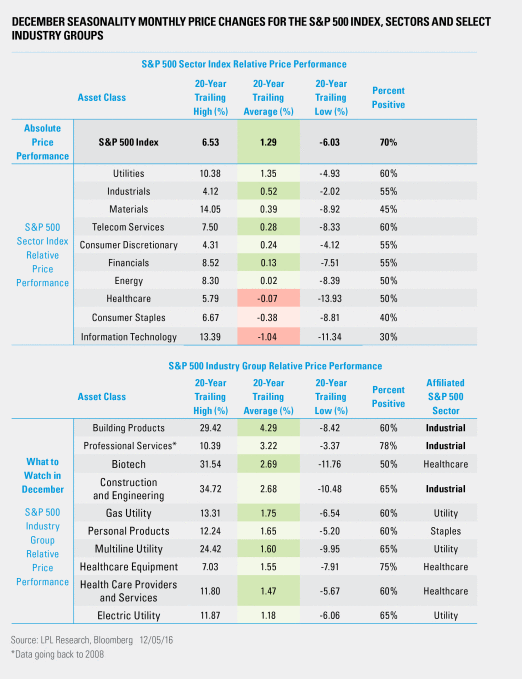by LPL Research
Over the last 20 years, December (much like November) has, on average, been a good month for the S&P 500. In addition to this broad seasonal pattern, some sectors have exhibited a seasonal tendency to outperform the S&P 500 in December, notably industrials.
LPL Research highlighted the strength of the industrials sector based on its November seasonal pattern in a recent blog. Reviewing the actual relative performance of the sector compared with the S&P 500 Index in November, the bullish November seasonal pattern held true: the industrials sector outperformed the broad-based index by 4.9% during the month.
Since 1996, the S&P 500’s average price change for December has been 1.3%, with a best return of 6.5% and a worst return of -6.0%. One way to attempt to capture the bullish December seasonal effects for stocks, should they persist, would be to invest in the overall equities market. Potential seasonal opportunities could also be considered, such as investing in sectors or industry groups within the S&P 500 that have historically outperformed the index in December. Comparing the price performance of an underlying sector or industry group to the broad-based index over a specific period can help identify the strongest seasonal performers compared with the overall market. However, performance is often driven by factors other than seasonality.
The sectors and industry groups that have outperformed the S&P 500 in December, on average, since 1996 are highlighted in green in the table below, and those that underperformed the index are highlighted in red.
Since 1996, the S&P 500 sector that outperformed the S&P 500 Index most consistently in December has been industrials, outperforming by an average of 0.5%, with a high of 4.1% and a low of -2.0% since 1996. Going a little deeper, we note three indicators of the industrial sector’s relative strength in December.
- The S&P 500 Building Products Industry Index has outperformed the S&P 500 Index, on average, by 4.3% in December, with a high of 29.4% and a low of -8.4%.
- The S&P 500 Professional Services Industry Index has outperformed the S&P 500, on average, by 3.2% in December, with a high of 10.4% and a low of -3.4%.
- The S&P 500 Construction and Engineering Industry Index has outperformed the S&P 500 Index, on average, by 2.7% in December, with a high of 34.7% and a low of -10.5%.
Importantly, out of the top five industry groups listed in the above table, the industrials sector represents three, suggesting further confirmation for relative strength during December. (We saw similar industrial sector breadth in November.)
December seasonal patterns and data over the past 20 years suggest that stocks may continue their climb higher with continued strength in the industrials sector. Understanding the seasonal metrics can be useful as an indication of underlying stock market strength, which may provide a timely opportunity to buy into the market on any potential dips.
*****
IMPORTANT DISCLOSURES
Past performance is no guarantee of future results. All indexes are unmanaged and cannot be invested into directly. Unmanaged index returns do not reflect fees, expenses, or sales charges. Index performance is not indicative of the performance of any investment.
The economic forecasts set forth in the presentation may not develop as predicted.
The opinions voiced in this material are for general information only and are not intended to provide or be construed as providing specific investment advice or recommendations for any individual security.
Stock investing involves risk including loss of principal.
Because of its narrow focus, specialty sector investing will be subject to greater volatility than investing more broadly across many sectors and companies.
Technical analysis is a methodology for evaluating securities based on statistics generated by market activity, such as past prices, volume and momentum, and is not intended to be used as the sole mechanism for trading decisions. Technical analysts do not attempt to measure a security’s intrinsic value, but instead use charts and other tools to identify patterns and trends. Technical analysis carries inherent risk, chief amongst which is that past performance is not indicative of future results. Technical analysis should be used in conjunction with fundamental analysis within the decision making process and shall include but not be limited to the following considerations: investment thesis, suitability, expected time horizon, and operational factors, such as trading costs are examples.
The S&P 500 Index is a capitalization-weighted index of 500 stocks designed to measure performance of the broad domestic economy through changes in the aggregate market value of 500 stocks representing all major industries.
This research material has been prepared by LPL Financial LLC.
To the extent you are receiving investment advice from a separately registered independent investment advisor, please note that LPL Financial LLC is not an affiliate of and makes no representation with respect to such entity.
Not FDIC/NCUA Insured | Not Bank/Credit Union Guaranteed | May Lose Value | Not Guaranteed by any Government Agency | Not a Bank/Credit Union Deposit
Securities and Advisory services offered through LPL Financial LLC, a Registered Investment Advisor
Member FINRA/SIPC
Tracking #1-561541 (Exp. 12/17)
Copyright © LPL Research















